Small overlap front
The small overlap front evaluation consists of a driver-side and a passenger-side component. If the results of the two evaluations differ, then the combined small overlap rating is equal to the lower rating.
Driver-side
- Rating applies to 2024 models
Tested vehicle: 2024 Mercedes-Benz GLE-Class 4-door 4wd
The Mercedes-Benz GLE-Class was redesigned for the 2024 model year. Driver-side small overlap frontal ratings are assigned by the Institute based on a test of a 2024 GLE conducted by Mercedes-Benz as part of frontal crash test verification.
| Overall driver-side evaluation | |
|---|---|
| Structure and safety cage | |
| Driver injury measures | |
| Head/neck | |
| Chest | |
| Hip/thigh | |
| Lower leg/foot | |
| Driver restraints and dummy kinematics | |
Measures of occupant compartment intrusion on driver side
| Test ID | VTN2309 |
|---|---|
| Lower occupant compartment | |
| Lower hinge pillar max (cm) | 2 |
| Footrest (cm) | 2 |
| Left toepan (cm) | 2 |
| Brake pedal (cm) | 4 |
| Parking brake (cm) | 0 |
| Rocker panel lateral average (cm) | 0 |
| Upper occupant compartment | |
| Steering column | 0 |
| Upper hinge pillar max (cm) | 1 |
| Upper dash (cm) | 1 |
| Lower instrument panel (cm) | 1 |
Driver injury measures
| Test ID | VTN2309 |
|---|---|
| Head | |
| HIC-15 | 258 |
| Peak gs at hard contact | no contact |
| Neck | |
| Tension (kN) | 1.6 |
| Extension bending moment (Nm) | 7 |
| Maximum Nij | 0.26 |
| Chest maximum compression (mm) | 28 |
| Femur (kN) | |
| Left | 0.9 |
| Right | 0.9 |
| Knee displacement (mm) | |
| Left | 2 |
| Right | 3 |
| Knee-thigh-hip injury risk (%) | |
| Left | 0 |
| Right | 0 |
| Maximum tibia index | |
| Left | 0.44 |
| Right | 0.48 |
| Tibia axial force (kN) | |
| Left | 1.8 |
| Right | 1.4 |
| Foot acceleration (g) | |
| Left | 52 |
| Right | 57 |
Passenger-side
- Rating applies to 2024 models
Tested vehicle: 2024 Mercedes-Benz GLE-Class 4-door 4wd
The Mercedes-Benz GLE-Class was redesigned for the 2024 model year. Passenger-side small overlap frontal ratings are assigned by the Institute based on a test of a 2024 GLE conducted by Mercedes-Benz as part of frontal crash test verification.
| Overall passenger-side evaluation | |
|---|---|
| Structure and safety cage | |
| Passenger injury measures | |
| Head/neck | |
| Chest | |
| Hip/thigh | |
| Lower leg/foot | |
| Passenger restraints and dummy kinematics | |
| Driver injury measures | |
| Head/neck | |
| Chest | |
| Hip/thigh | |
| Lower leg/foot | |
| Driver restraints and dummy kinematics | |
Measures of occupant compartment intrusion on passenger side
| Test ID | VTP2315 |
|---|---|
| Lower occupant compartment | |
| Lower hinge pillar max (cm) | 6 |
| Footrest (cm) | 9 |
| Right toepan (cm) | 6 |
| Center toepan (cm) | 4 |
| Rocker panel lateral average (cm) | 2 |
| Upper occupant compartment | |
| Center dash (cm) | 1 |
| Upper hinge pillar max (cm) | 4 |
| Upper dash (cm) | 4 |
| Right lower dash (cm) | 4 |
Passenger injury measures
| Test ID | VTP2315 |
|---|---|
| Head | |
| HIC-15 | 220 |
| Peak gs at hard contact | no contact |
| Neck | |
| Tension (kN) | 1.3 |
| Extension bending moment (Nm) | 11 |
| Maximum Nij | 0.20 |
| Chest maximum compression (mm) | 21 |
| Femur (kN) | |
| Left | 0.6 |
| Right | 0.8 |
| Knee displacement (mm) | |
| Left | 1 |
| Right | 1 |
| Knee-thigh-hip injury risk (%) | |
| Left | 0 |
| Right | 0 |
| Maximum tibia index | |
| Left | 0.24 |
| Right | 0.26 |
| Tibia axial force (kN) | |
| Left | 2.5 |
| Right | 2.6 |
| Foot acceleration (g) | |
| Left | 59 |
| Right | 78 |
Driver injury measures
| Test ID | VTP2315 |
|---|---|
| Head | |
| HIC-15 | 143 |
| Peak gs at hard contact | no contact |
| Neck | |
| Tension (kN) | 1.1 |
| Extension bending moment (Nm) | 6 |
| Maximum Nij | 0.22 |
| Chest maximum compression (mm) | 32 |
| Femur (kN) | |
| Left | 0.9 |
| Right | 0.4 |
| Knee displacement (mm) | |
| Left | 3 |
| Right | 1 |
| Knee-thigh-hip injury risk (%) | |
| Left | 0 |
| Right | 0 |
| Maximum tibia index | |
| Left | 0.35 |
| Right | 0.30 |
| Tibia axial force (kN) | |
| Left | 1.4 |
| Right | 1.5 |
| Foot acceleration (g) | |
| Left | 32 |
| Right | 47 |
Moderate overlap front: original test
Rating applies to 2024 models
Tested vehicle: 2024 Mercedes-Benz GLE 350 4-door 4wd
The Mercedes-Benz GLE-Class was redesigned for the 2024 model year. Two moderate overlap frontal tests were conducted, one by the Institute and the other by Mercedes-Benz as part of frontal crash test verification. Ratings are based on both tests, but the vehicle specifications shown below are based on the Institute’s test.
| Overall evaluation | |
|---|---|
| Structure and safety cage | |
| Driver injury measures | |
| Head/neck | |
| Chest | |
| Leg/foot, left | |
| Leg/foot, right | |
| Driver restraints and dummy kinematics |
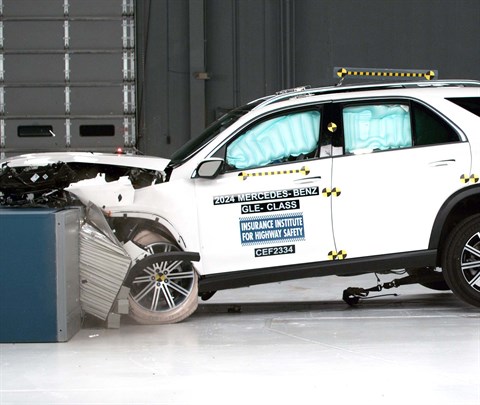
Action shot taken during the Institute's moderate overlap frontal crash test.
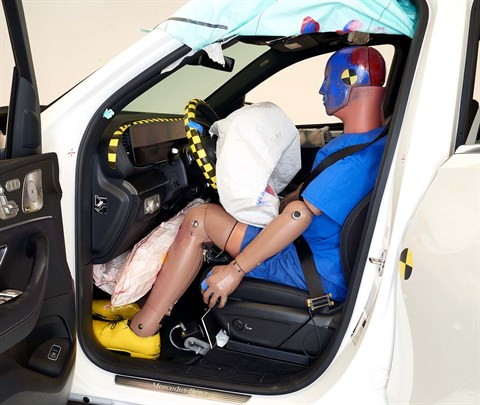
The dummy's position in relation to the steering wheel and instrument panel after the crash test indicates that the driver's survival space was maintained very well (Institute test car shown).
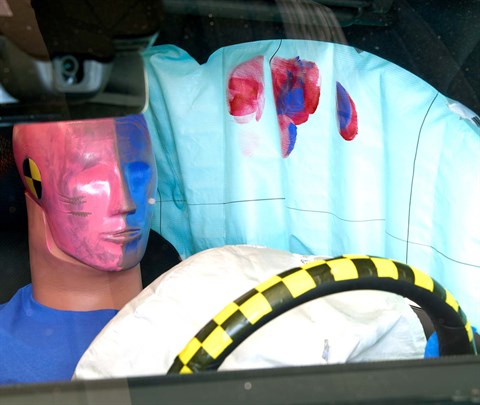
Smeared greasepaint indicates where the dummy's head contacted the side curtain airbag during rebound (Institute test car shown).
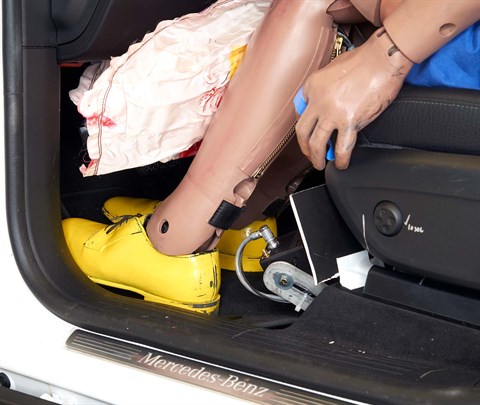
Intrusion into the driver's space was minimal, and all leg and foot injury measures were low (Institute test car shown).
Measures of occupant compartment intrusion on driver side
| Test ID | VTF2314 | CEF2334 |
|---|---|---|
| Footwell intrusion | ||
| Footrest (cm) | 1 | 2 |
| Left (cm) | 1 | 3 |
| Center (cm) | 1 | 2 |
| Right (cm) | 1 | 2 |
| Brake pedal (cm) | 1 | 2 |
| Instrument panel rearward movement | ||
| Left (cm) | -1 | 0 |
| Right (cm) | 0 | 0 |
| Steering column movement | ||
| Upward (cm) | -1 | 1 |
| Rearward (cm) | -6 | -2 |
| A-pillar rearward movement (cm) | 0 | 0 |
Driver injury measures
| Test ID | VTF2314 | CEF2334 |
|---|---|---|
| Head | ||
| HIC-15 | 257 | 232 |
| Peak gs at hard contact | no contact | no contact |
| Neck | ||
| Tension (kN) | 1.3 | 1.3 |
| Extension bending moment (Nm) | 23 | 11 |
| Maximum Nij | 0.26 | 0.23 |
| Chest maximum compression (mm) | 32 | 31 |
| Legs | ||
| Femur force - left (kN) | 1.2 | 0.9 |
| Femur force - right (kN) | 0.9 | 0.9 |
| Knee displacement - left (mm) | 2 | 2 |
| Knee displacement - right (mm) | 3 | 2 |
| Maximum tibia index - left | 0.33 | 0.32 |
| Maximum tibia index - right | 0.46 | 0.35 |
| Tibia axial force - left (kN) | 1.8 | 1.9 |
| Tibia axial force - right (kN) | 2.4 | 2.3 |
| Foot acceleration (g) | ||
| Left | 76 | 61 |
| Right | 61 | 68 |
Moderate overlap front: updated test
Rating applies to 2024 models
Tested vehicle: 2024 Mercedes-Benz GLE 350 4-door 4wd
The Mercedes-Benz GLE-Class was redesigned for the 2024 model year.
| Overall evaluation | |
|---|---|
| Structure and safety cage | |
| Driver injury measures | |
| Head/neck | |
| Chest | |
| Thigh/hip | |
| Leg/foot | |
| Driver restraints and dummy kinematics | |
| Rear passenger injury measures | |
| Head/neck | |
| Chest | |
| Thigh | |
| Rear passenger restraints and dummy kinematics | |
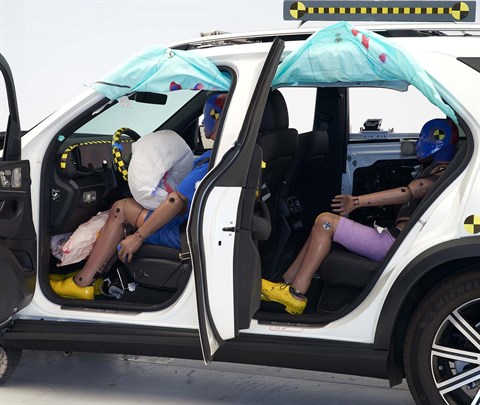
View of the vehicle after the crash showing the airbags and damage to the occupant compartment.
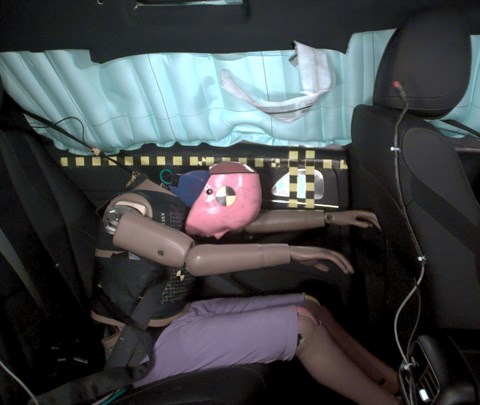
The rear passenger dummy's head remained a safe distance from the front seatback.
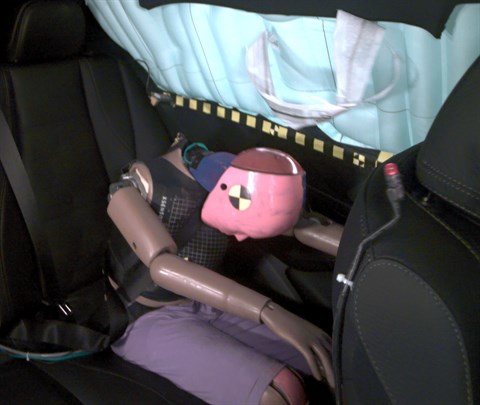
Rear passenger dummy injury values indicate a low risk of injury to the chest and a moderate risk of injury to the head or neck. During the crash, the shoulder belt remained in an ideal position on the dummy’s chest.
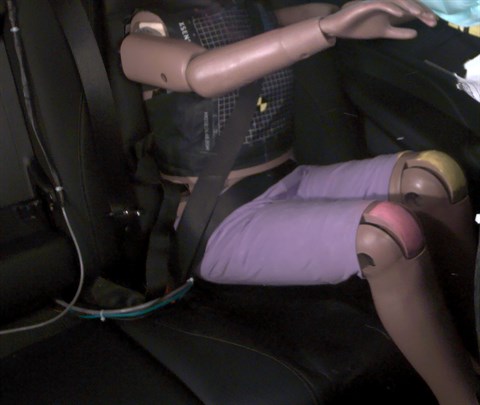
The rear passenger dummy's lap belt remained in the ideal position on the pelvis.
Measures of occupant compartment intrusion on driver side
| Test ID | CEF2334 |
|---|---|
| Footwell intrusion | |
| Footrest (cm) | 2 |
| Left (cm) | 3 |
| Center (cm) | 2 |
| Right (cm) | 2 |
| Brake pedal (cm) | 2 |
| Instrument panel rearward movement | |
| Left (cm) | 0 |
| Right (cm) | 0 |
| Steering column movement | |
| Upward (cm) | 1 |
| Rearward (cm) | -2 |
| A-pillar rearward movement (cm) | 0 |
Driver injury measures
| Test ID | CEF2334 |
|---|---|
| Head | |
| HIC-15 | 232 |
| Peak gs at hard contact | no contact |
| Neck | |
| Tension (kN) | 1.3 |
| Extension bending moment (Nm) | 11 |
| Maximum Nij | 0.23 |
| Chest maximum compression (mm) | 31 |
| Femur (kN) | |
| Left | 0.9 |
| Right | 0.9 |
| Knee displacement (mm) | |
| Left | 2 |
| Right | 2 |
| Knee-thigh-hip injury risk (%) | |
| Left | 0 |
| Right | 0 |
| Maximum tibia index | |
| Left | 0.32 |
| Right | 0.35 |
| Tibia axial force (kN) | |
| Left | 1.9 |
| Right | 2.3 |
| Foot acceleration (g) | |
| Left | 61 |
| Right | 68 |
Rear passenger injury measures
| Test ID | CEF2334 |
|---|---|
| Head | |
| HIC-15 for head contact during forward excursion |
no contact
|
| Peak gs at hard contact | no contact |
| Neck | |
| Tension (kN) | 2.1 |
| Compression (kN) | 0.6 |
| Maximum Nij for head contact during forward excursion |
no contact
|
| Chest | |
| Chest index | 29 |
| Shoulder belt tension (kN) | 5.9 |
| Thigh (kN) | |
| Left femur compression | 0.2 |
| Right femur compression | 0.2 |
Side: updated test
Rating applies to 2024 models
Tested vehicle: 2024 Mercedes-Benz GLE-Class 4-door 4wd
The Mercedes-Benz GLE-Class was redesigned for the 2024 model year. Side 2.0 ratings are assigned by the Institute based on a test of a 2024 GLE conducted by Mercedes-Benz as part of side crash test verification.
| Overall evaluation | |
|---|---|
| Structure and safety cage | |
| Driver injury measures | |
| Head/neck | |
| Torso | |
| Pelvis | |
| Driver head protection | |
| Rear passenger injury measures | |
| Head/neck | |
| Torso | |
| Pelvis | |
| Rear passenger head protection | |
Measures of occupant compartment intrusion on driver side
| Test ID | VTS2331 |
|---|---|
| B-pillar to longitudinal centerline of driver's seat (cm) | -19.5 |
| Negative numbers indicate the amount by which the crush stopped short of the seat centerline. | |
Driver injury measures
| Test ID | VTS2331 |
|---|---|
| Head | |
| HIC-15 | 50 |
| Peak gs at hard contact | no data |
| Neck | |
| Tension (kN) | 0.9 |
| Compression (kN) | -0.2 |
| Shoulder | |
| Lateral deflection (mm) | 22 |
| Lateral force (kN) | 0.7 |
| Torso | |
| Maximum deflection (mm) | 34 |
| Average deflection (mm) | 30 |
| Maximum deflection rate (m/s) | 2.86 |
| Maximum viscous criterion (m/s) | 0.45 |
| Pelvis | |
| Combined force (kN) | 4.6 |
Passenger injury measures
| Test ID | VTS2331 |
|---|---|
| Head | |
| HIC-15 | 232 |
| Peak gs at hard contact | no contact |
| Neck | |
| Tension (kN) | 0.4 |
| Compression (kN) | -0.4 |
| Shoulder | |
| Lateral deflection (mm) | 7 |
| Lateral force (kN) | 0.4 |
| Torso | |
| Maximum deflection (mm) | 17 |
| Average deflection (mm) | 12 |
| Maximum deflection rate (m/s) | 3.00 |
| Maximum viscous criterion (m/s) | 0.16 |
| Pelvis | |
| Combined force (kN) | 5.0 |
Headlights
Ratings are given for 2 different headlight variations available on this vehicle.
Trim level(s)
-
All trims
| Low-beam headlight type | LED reflector |
|---|---|
| High-beam headlight type | LED reflector |
| Curve-adaptive? | No |
| High-beam assist? | Yes |
| Overall rating |
|
| Distance at which headlights provide at least 5 lux illumination: | |
Low beams
On the straightaway, visibility was good on both sides of the road. On curves, visibility was good on both right curves, fair on the sharp left curve and inadequate on the gradual left curve.
The low beams never exceeded glare limits.
High beams
On the straightaway, visibility was good on both sides of the road. On curves, visibility was good on both right curves and fair on both left curves.
High-beam assist compensates for some limitations of this vehicle's low beams on both left curves.
| Trim level(s) |
|
|---|---|
| Low-beam headlight type | LED reflector |
| High-beam headlight type | LED reflector |
| Curve-adaptive? | No |
| High-beam assist? | Yes |
| Overall rating Applies to 2024 models |
| LOW BEAMS | Average minimum useful illumination distance (5 lux) |
Amount glare exceeded threshold |
|---|---|---|
| Straightaway right edge | 110.8 m | None |
| Straightaway left edge | 61.6 m | None |
| 250m radius right curve, right edge | 71.4 m | None |
| 250m radius left curve, right edge | 44.4 m | None |
| 150m radius right curve, right edge | 60.2 m | None |
| 150m radius left curve, left edge | 48.6 m | None |
| HIGH BEAMS | Average minimum useful illumination distance (5 lux) |
|---|---|
| Straightaway right edge | 176.8 m |
| Straightaway left edge | 151.2 m |
| 250m radius right curve, right edge | 84.1 m |
| 250m radius left curve, left edge | 72.0 m |
| 150m radius right curve, right edge | 65.7 m |
| 150m radius left curve, left edge | 58.3 m |
Trim level(s)
-
All trims equipped with Advanced Lighting package
| Low-beam headlight type | LED projector |
|---|---|
| High-beam headlight type | LED projector |
| Curve-adaptive? | Yes |
| High-beam assist? | Yes |
| Overall rating |
|
| Distance at which headlights provide at least 5 lux illumination: | |
Low beams
On the straightaway, visibility was fair on the left side of the road and inadequate on the right side. On curves, visibility was good on the sharp left and both right curves and fair on the gradual left curve.
The low beams created some glare.
High beams
On the straightaway, visibility was good on both sides of the road. On curves, visibility was good in all 4 tests.
High-beam assist compensates for some limitations of this vehicle's low beams on the straightaway and on both left curves.
| Trim level(s) |
|
|---|---|
| Low-beam headlight type | LED projector |
| High-beam headlight type | LED projector |
| Curve-adaptive? | Yes |
| High-beam assist? | Yes |
| Overall rating Applies to 2024 models |
| LOW BEAMS | Average minimum useful illumination distance (5 lux) |
Amount glare exceeded threshold |
|---|---|---|
| Straightaway right edge | 76.6 m | None |
| Straightaway left edge | 54.5 m | None |
| 250m radius right curve, right edge | 83.5 m | None |
| 250m radius left curve, right edge | 63.3 m | 26.6% |
| 150m radius right curve, right edge | 73.2 m | None |
| 150m radius left curve, left edge | 56.1 m | None |
| HIGH BEAMS | Average minimum useful illumination distance (5 lux) |
|---|---|
| Straightaway right edge | 145.9 m |
| Straightaway left edge | 158.0 m |
| 250m radius right curve, right edge | 91.4 m |
| 250m radius left curve, left edge | 97.2 m |
| 150m radius right curve, right edge | 78.7 m |
| 150m radius left curve, left edge | 79.3 m |
Front crash prevention: pedestrian
Ratings are given for 2 different systems available on this vehicle.
Seat belt reminders
Rating applies to 2024 models
| Overall evaluation | |
|---|---|
| Front row | |
| Unbelted occupant alert (audible & visual) | |
| Initiation time | |
| Duration | Long enough (90+ seconds) |
| Volume | |
| Audio frequency | |
| Second row | |
| Startup status alert (visual) | |
| Initiation time | |
| Duration at least 60 seconds | |
| Belt disengaged alert (audible & visual) | |
| Initiation time | |
| Duration at least 30 seconds | |
| Volume | |
| Audio frequency |
| Background cabin sound pressure level at 24 km/h | 50 dB |
| Audible signal sound pressure level at 24 km/h | 74 dB |
| Difference between background and signal | 23.0 dB |
| Background cabin sound pressure level at 40 km/h | 53 dB |
| Audible signal sound pressure level at 40 km/h | 71 dB |
| Difference between background and signal | 17.7 dB |
| Dominant audio frequency | 664 Hz |
